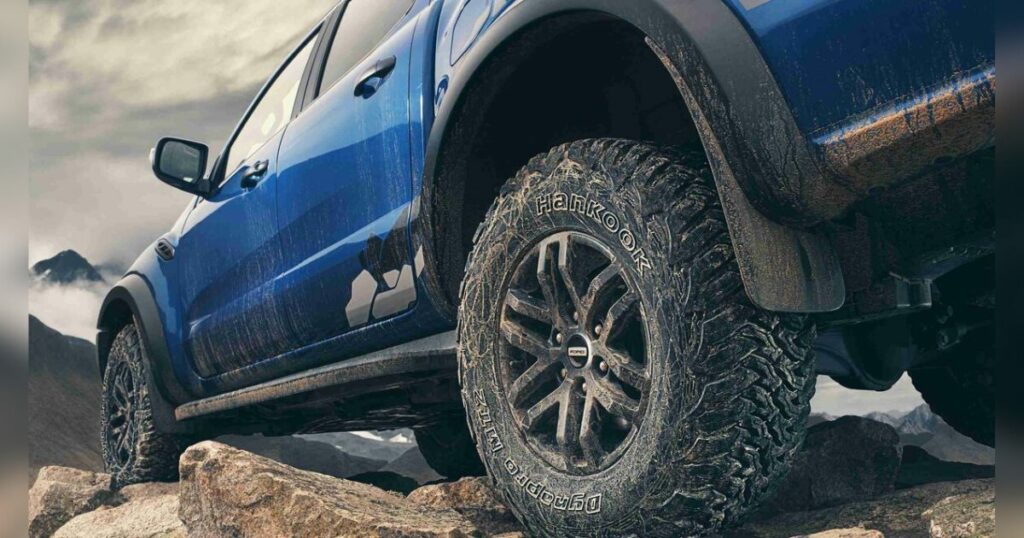
If you are trying to choose a new pair of truck tires, chances are you might get overwhelmed by the variety of options. This is true for most truck owners. Many light truck tires (highway, all-terrain, off-road, winter tires, etc.) are available on the market. In addition, multiple companies provide products in each tire category. Tire manufacturers update these products often, with new models appearing every 5-6 years.
This article intends to help every truck owner choose the perfect set of tires that works well for their needs, regardless of how or where they typically use their truck. Let us deep-dive into the top light truck tires on the market (2023), including any brand-new releases, and evaluate them.
How to select a light truck tires
Load Ratings
Tire loading capacity for light trucks is designated in two different conventions, ‘Load Index and ‘Load Rating’. The ‘Load Index’ is used for P-metric tires, while the ‘Load Rating’ is used for LT-metric tires.
The tire loading capacity “LT” and “P” appear to the immediate left of the tire size. Tires with LT-metric must be considered for trucks carrying heavier cargo. Tires with a P-metric rating are suitable for light trucks with a gross vehicle weight rating of up to half a ton. The difference between the two is that the sidewalls of LT-metric tires are stronger and can support heavier loads.
Tires marked as LT-metric, LT-flotation, or LT-numeric will have the applicable load range designation (B, C, D, etc.) to the immediate right of the tire size, such as LT245/75R-16 E, 7.50R-15 D, or 31×10.50R-15 C, along with the corresponding load range number on the sidewall. The maximum loads, ply ratings, and cold tire pressures are interpreted from the load range look-up table for LT-Metric, LT-Flotation, and LT-Numeric Light Truck Tires.
The load rating of each tire should be considered before making a final choice. For example, if your truck weighs 12,000 lbs, it will require a tire with a minimum weight capacity of 3,000 lbs. The maximum load capacity of the tire is mentioned on the tire sidewall.
Weather Factor
The weather conditions where the truck operates are essential in choosing the right tire. “M/T” or mud-terrain tires would be the best fit for rainy weather with sticky off-road conditions. For extremely low temperatures where the surface is largely ice and snow, it is always essential to use tires whose compound can remain sufficiently soft in low temperatures. It is, therefore, important to use tires that have the word “Winter(snow)” or “Ice” in the product name in such weather conditions.
Size

Standard and flotation truck tires are the most common tire conventions. The standard convention is rapidly replacing the older “flotation” system. A truck tire’s identification number will always consist of two groups of numbers followed by the tire size and wheel (rim) diameter.
Tire sidewalls may be marked as either 35X12.5R18 or 135/70-18 in size. For a radial tire suitable for an 18-inch wheel, the first set of digits (35 x 12.5) indicates a “flotation” size, or in other words, the width and height of the tire’s tread and sidewall in inches.
The second set is specified and represents a tire with a 135mm tread width and a 70% sidewall (also called “aspect ratio”). The R still denotes radial construction, while the 18 specifies an 18-inch wheel size.
Changing the diameter of the wheel will cause a corresponding shift in the tire’s aspect ratio. The lower the aspect ratio, the bigger the wheel. This proportion maintains a constant tire/wheel diameter.
Different Product Categories of Light Truck Tires
The right tire category must be chosen depending on the nature of work that a truck owner wants his/her truck to perform. Here is a brief description of the product categories of tires available in the market.
All-Season Tires
All-season Highway Tires are built to last longer and provide a more comfortable ride in various weather conditions. Although they won’t compare to off-road or winter tires in terms of grip, they are suitable for most road conditions and terrain.
All-Terrain Tires
All-Terrain Tires are designed to maximize traction and stability off-road. Typically, these tires have a gentler tread and an increased tread surface (knobs) for traction. Additionally, they have a shorter tread life and wider sidewalls. These tires are generally designated by “A/T” or “AT.”
Winter Tires
Winter and Snow Tires are made with compounds engineered to maintain traction and pliability when temperatures decrease. Their tread patterns will be able to remove ice and snow and “spread” to provide greater traction on slick surfaces.
Off-Road Tires
Off-road tires are intended for unpaved terrain. They are differentiated by the “M/T” in their designation, for example, the Firestone Destination M/T2. These tires have large tread elements that make a large footprint, resulting in traction on uneven surfaces.
Off-road tires also provide adequate dry and damp surface traction to ensure safe highway cruising. In addition to their excellent traction, off-road tires are damage resistant and have a high load capacity.
Highway Tires
Highways tires are truck tires designed primarily for highway usage. Highway tires are built to last longer, produce less noise, and provide a more comfortable ride than those designed for low-speed applications like off-road and all-terrain tires.
Highway truck tires are also known in the industry as H/T tires. In most cases, they also provide better fuel efficiency compared to all-terrain tires. H/T tires are designed for a wide range of applications, including SUVs, crossovers, pickup trucks, and full-size vans, and are also designed to provide traction in dry, wet, and icy situations.
Performance Tires
Performance Tires or Sport Tires aim to give drivers a sense of security and provide a more engaging driving experience. In addition to increased traction on paved surfaces, these tires’ speed ratings are higher than other light truck tires. Since most buyers are unlikely to race their trucks on a track, finding performance tires in light truck sizes is challenging.
Are All-Terrain Tires A Big Compromise?
By their very nature, all-terrain tires are a huge compromise. The goal in developing this rubber was to create a tire that would perform well in a wide variety of conditions, from racing through the sand to wading through mud to climbing over rocks to speeding down the highway. Some tires with this idea use multi-pitch tread, while others utilize sidewall shoulder lugs or adjust the distance between tread blocks to increase their versatility.
All-terrain tires, like every other compromise, do not excel at anything. However, several AT tires on the market are versatile in handling trail driving, desert runs, water barriers, and even icy situations, making them an excellent choice for non-specialized off-road trips. All-terrain tires come with their own set of advantages and disadvantages.
Pros
- Open-tread design
- The tires’ grip on non-paved terrain is enhanced by numerous interlocking tread components that give the tire a firm grip on rocks and mud while allowing for decent control on smooth routes.
- Reinforced sidewalls
- Some variations of all-terrain tires include reinforced sidewalls, allowing them to handle greater loads.
- All-year operability
- Because of their versatility, all-terrain tires may be used in various weather conditions, including snow and ice.
Cons
- Road Noise
- The “block tread” design of all-terrain tires makes them louder than standard all-season tires. Block-tread designs increase the volume of mud that off-road and all-terrain tires can displace. This also modifies the acoustics of the air passing through the grooves in the tread, resulting in loud road noise.
- Tires wear out faster.
- Due to the weaker rubber, the tires will wear out sooner than the typical 40,000 miles. These compounds aid all-terrain tires in functioning adequately on various terrains. Longer-lasting tire versions are available with 50,000-70,000 miles of tread life.
- Cupping susceptibility
- Due to their construction, all-terrain tires are prone to cupping. The more aggressive the tire, the more likely it is to cup.
- Increased fuel consumption
- Tread pattern, mechanical friction, and wind and rolling resistance all contribute to increased fuel consumption.
The Best Light Truck Tires in 2023
There is fierce competition in the light truck tire market in 2023. This makes it challenging to pick the top three or even the top five products since there numerous high-quality products available from various manufacturers. Hence we decided to handpick the top light truck tires available in each product category.
Best overall tires for light trucks
Continental TerrainContact H/T
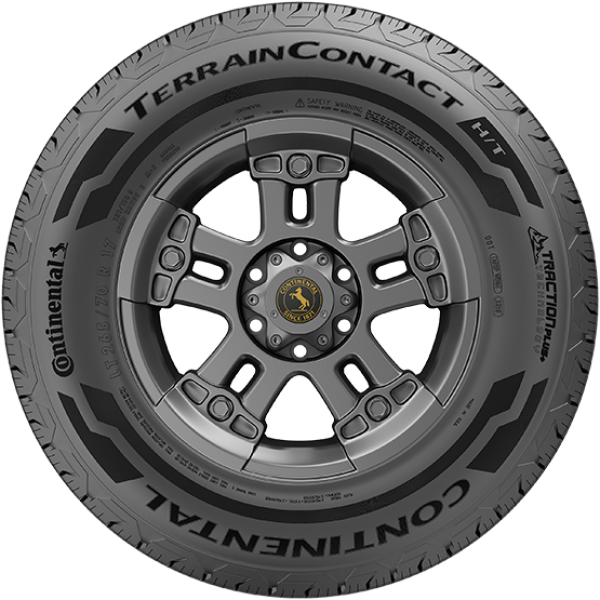
The TerrainContact H/T is the finest all-season light-truck tire on the market for those who don’t regularly venture off-road. This all-season highway tire demonstrates superior rainy weather performance compared to the competition. Its wet handling is superior to its rivals, with excellent limit behavior.
In addition, this tire has great grip and traction on dry roads, handles well, and stops quickly. Surprisingly, unlike other highway all-season tires, the TerrainContact H/T performs admirably on snow-covered terrain. The TerrainContact H/T demonstrates outstanding traction under acceleration and panic braking in snowy conditions.
The TerrainContact H/T gives a well-controlled ride over bumps and silent operation at high speeds despite its great all-around performance. In addition, it has a fantastic treadwear warranty, and its owners are generally pleased with the tread life they’ve experienced.
The TerrainContact H/T, however, does come with its set of flaws. Its off-road performance lags well below the competition, and its handling isn’t as precise or responsive.
Pros
- Numerous cutting-edge mechanisms
- Suitable for a variety of terrain
- Good ride comfort
- Good lateral grip even on wet pavement
Cons
- Pricey
- Not suitable for deep snow conditions
- Less than adequate off-road capability
Best All-Season tires for light trucks
Continental CrossContact LX25
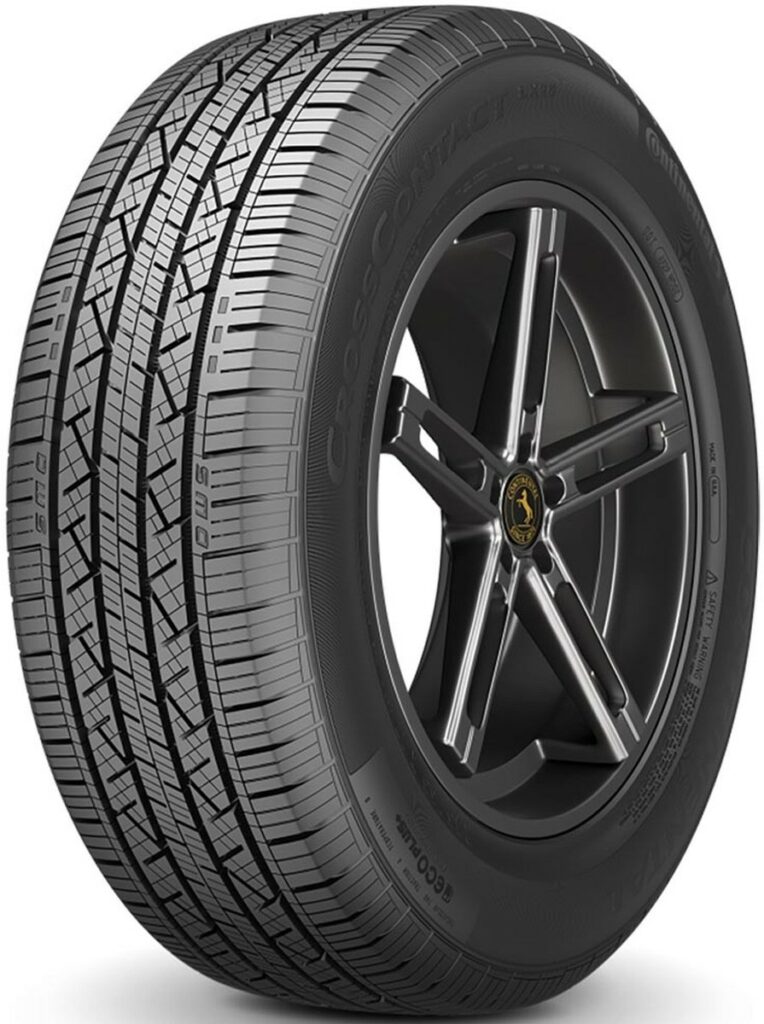
The LX25’s handling on damp terrain is impressive. It offers reliable grip and superior traction. This new and improved tire will meet the needs of most truck owners. The LX25 is safe and recommended for use on public roads while ensuring low road noise. The tire’s sturdy design and high-quality ensure a long service life of upto three years. In snow, the tire does function capably.
Pros
- Superior performance on any surface
- Rolling effortlessly and lightly
- Good performance under light snow conditions
- Competitive Pricing
- Excellent control and stopping ability
Cons
- Performance deterioration under heavy loads
Best All-Terrain tires for light trucks
Goodyear Wrangler All-Terrain Adventure With Kevlar
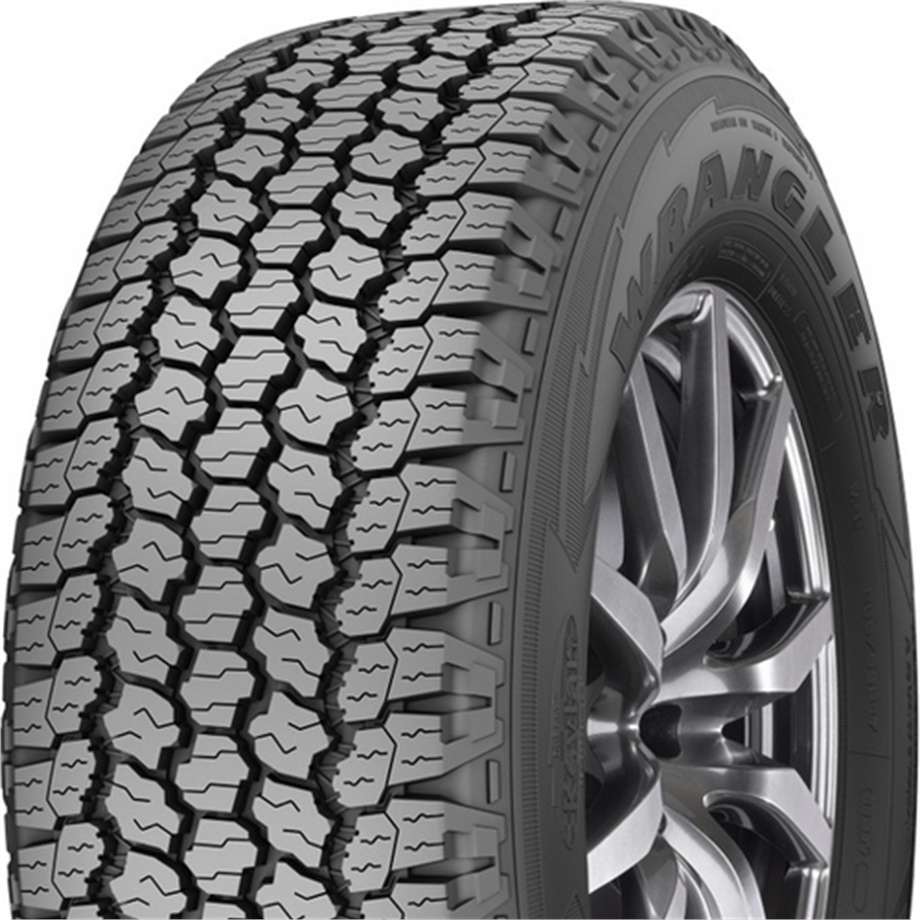
As with numerous other off-road tires, the Goodyear Wrangler is a pioneer of the genuine off-road genre. It outperforms several competitor tires in the off-road space on both hard terrain and soft mud terrain. However, the tire’s performance does suffer significantly in extremely muddy conditions, especially in bogs deeper than 5 inches.
The Goodyear Wrangler is one of the longest-lasting tires available. The 2023 model’s durability and off-road prowess are thanks to the premium materials, like Kevlar, with which it is constructed. The tire also excels under steady highway cruising. The tire gives a satisfying ride regardless of the road surface.
There are a number of drawbacks in the Goodyear Wrangler that might potentially shorten a vacation plan. For example, the noise level while driving and the lack of a manufacturer’s guarantee are particularly unsettling aspects. Tire noise is distinctly noticeable whilst driving on highways.
Pros
- Effective on any surface
- Superb road hold
- Security when driving
- Appropriate for the cost
- Extremely sturdy build quality
Cons
- Loud tire noise while driving
Best winter tires for light trucks
Bridgestone Blizzak DM-V2
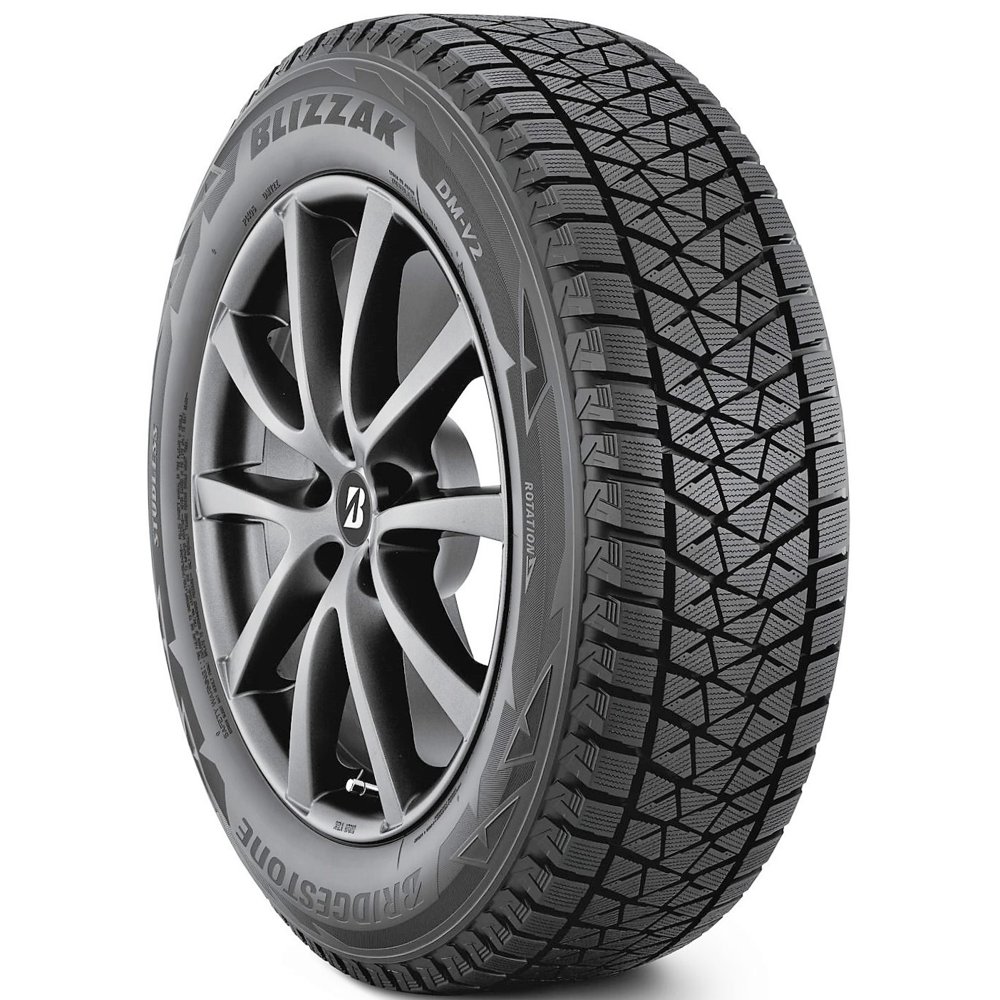
The Blizzak is an excellent choice for those who frequently have to drive in snow, slush, or on slippery roads due to where you reside. The Blizzaks are made of a Bridgestone compound that can maintain flexibility even when the temperature drops below freezing, repel compacted snow and water, and provide excellent traction on smooth ice.
With three-dimensional zigzag sipes for grip and a directed tread pattern with sharp block edges, water, slush, and snow are all blasted out from the contact area and away from the tire. The Blizzak DM-V2 is marked with the three-peak mountain snowflake (3PMSF) sign, indicating that it satisfies stringent snow service criteria.
The Bridgestone Blizzak DM-V2 has received positive reviews and a 4.5-star rating from Tire Rack customers, solidifying its position as one of the best snow tires on the market.
Pros
- Superb control in the snow
- Overcomes hydroplaning
- An indicator showing tire wear
Cons
- Summer heat accelerates wear.
- Road noise is higher compared to all-season tires
- All four tires must be a match.
Michelin X-Ice Xi3

Over the years of this product’s existence, the Michelin X-Ice Xi3 has demonstrated superior quality and dependable performance. Other winter tire models tend to become immobile after repeated driving over thick ice.
In Xi3, however, such events are uncommon, thus giving greater confidence while driving. This model still performs admirably even under low temperatures combined with muddy terrain. These tires enable the truck to escape from even the most tricky situations.
This cutting-edge tire features a guarantee that covers 40.000 miles of driving. Compared to competing winter models from other manufacturers, this number is outstanding. This tire’s lifespan could last up to seven years with proper maintenance.
There are very few drawbacks to the Xi3. The main one is its high price making the Xi3 out of reach for many folks. However, the thick tire wall makes it difficult to maneuver around obstructions.
Pros
- The Best Traction in the Snow
- Long service life
- Competitive 40,000 km manufacturer warranty
- Outperforms competitors in wet, slick conditions
Cons
- High price
- Poor handling
Best Off-Road Tires for Light Trucks
Yokohama Geolandar M/T
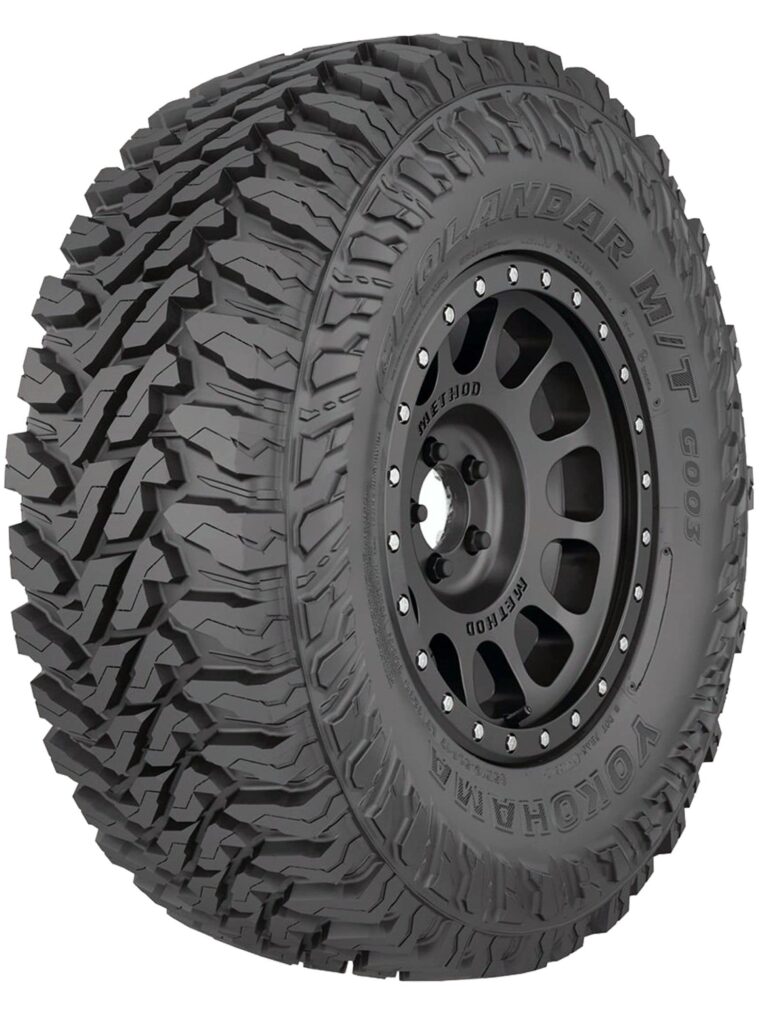
The Geolandar M/T G003 is built with a new triple-polymer blend and a higher silica content in the tread compound. This high-density material can withstand harsh off-road environments.
The tire’s touch sidewall design and hefty shoulder blocks on the tread’s outer border prevent rock punctures in the sidewalls. They provide improved traction and extra grip in difficult conditions. Stability on and off the road is further improved by optimized grooves and rigid solid tread blocks that help displace stone, sand, or mud from the tire’s path.
Combining a high-void tread pattern and variable-pitch blocks helps reduce road noise. However, Geolandar M/T G003 performs poorly in deep snow due to the presence of less dense snow-biting sipes.
The Geolandar M/T G003’s casing is made stronger by combining three polyester body plies, two high-strength steel belts, and a full-width nylon cap. This greatly helps extend the tread life of the tire.
Pros
- Superior traction on all surfaces except thick snow
- Superior-quality rubber compound for the tread
- New and improved sidewall and tread design
- Superior tread life compared to the competition
Cons
- Distinct road noise
- Not the best option for thick snow and ice
Best Highway Tires for Light Trucks
Michelin Defender LTX M/S
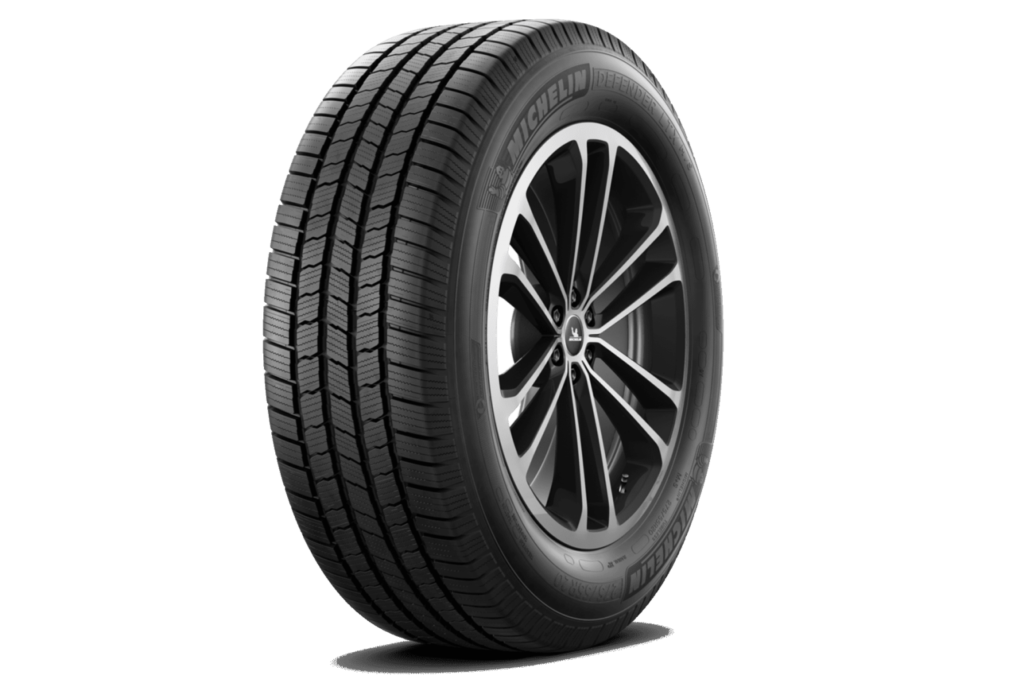
The Michelin Defender LTX M/S is considered one of the best highway truck tires. Customers give the Defender LTX M/S a 4.5-star rating for durability, ride quality, long tread life, and all-season capabilities. One common criticism of the Defender LTX M/S is that it’s more expensive than other highway tires from other brands.
Some truck owners feel that the tire’s performance in snow and ice could have been better. Reviews also describe the ride quality to be substantially rougher over uneven pavement. While tire noise levels also appear to vary depending on the state of the road. The possible reason for this could be that, although the Defender LTX M/S does work well on light trucks, it was designed with vans, crossovers, and SUVs in mind.
Pros
- Good ride comfort
- Long-lasting tread
- Excellent in wet
Cons
- Expensive
- As bad in the snow/mud as it is in the rain
- Extremely loud and abrasive on rougher roads.
Frequently Asked Questions (FAQs)
Are highway all-season tires good for off-roading?
The answer is yes and no. Typical Highway All-Season tires have smaller tread depths and milder tread patterns, allowing them to grip the road smoothly while causing less noise. Beyond driving down a gravel driveway or to the local grocer, highway all-season tires are not intended for genuine off-roading.
How long should light truck tires last?
Most tire manufacturers use treadwear/mileage warranties to promote their tires competitively. This could range anywhere between 30,000 to 100,000 miles. However, due to the wide range of road conditions and geographic influences encountered nationwide, not all consumers will receive the warranted treadwear/mileage.
What does LTX on a tire mean?
The letters “LTX” on a truck tire indicates that the tire falls in the all-season category and is designed for light trucks and SUVs.
Which is the best tire for a truck?
There is no easy solution since there is no such thing as the perfect tire. Some truck owners want their vehicles to drive on the highway without road noise. While others seek off-road traction. Those two buyers have completely different tire needs.
Those who prefer long-lasting tires to those with exceptional wet-weather traction are in the same boat. Finding a tire that fits your demands while staying within your price range requires first determining what those needs are. Depending on what you want your tires to be good at, the broad categories for light truck tires are –
- All-Season Tires
- Winter Tires
- Off-Road Tires
- All-Terrain Tires
- Performance Tires
Which tire could be considered the longest-lasting truck tire?
Launched in 2019, the Continental TerrainContact H/T has a mileage rating of 95,000 miles, making it one of the most durable all-season truck tires on the market.
Regarding mileage, TerrainContact H/T has proven it is worthy of the highest UTQG (Uniform Tire Quality Grade) treadwear value of 800. When comparing any two given tires, if one tire has a higher UTQG value, the higher-value tire will take much longer to wear out its tread.
How often should a truck’s tires be rotated?
Rotating tires is more about the tire than it is about the vehicle. A typical rotation interval is 5,000 to 7,000 miles or so, but for practical purposes, tire rotation is often done when normal vehicle maintenance (oil change, filter change, etc.) is done.
That usually coincides fairly closely to tire make and manufacturer recommendations. Be aware that on some trucks, the tires used on the steer axle cannot be put on the drive axle (rear) and vice versa. Use the truck’s owner’s manual for the recommended tire rotation pattern.
What is the best tire pressure for trucks?
In the case of light trucks, there are a huge variety of tires with different load ratings that fit any given truck’s wheel hub. Therefore, the recommended inflation pressure for light truck tires corresponds to the load range designation (B, C, D, etc.) mentioned on a particular tire’s sidewall. For example, the maximum load pressure for a tire with load range designation ‘B’ is 35 psi per the load rating chart.
How often should you replace your tires? Can tires last 100,000 miles?
Tires should be replaced when their tread depth is no longer suitable for the weather. According to experts, tires must be replaced when they have around 5/32″ of remaining tread depth for driving in snow, 4/32″ for wet roads, and 2/32″ for dry roads.
Tires that are five years or older should be evaluated regularly for symptoms of aging. This inspection can only verify the outer rubber’s condition but will not identify any wear or damage on the interior. Tires that have been in storage for longer than six years should not be utilized, regardless of how well they were stored.
As a safety measure, all tires (including spares) made more than ten years ago should be replaced, even if they look fine and haven’t worn down to the legal limit. Products like the Continental TerrainContact H/T actually do give a tread life of close to 100,000 miles.
Conclusion
In this article, we have looked at the different design aspects of light truck tires, like size, application, and load rating. It is essential to consider these aspects when purchasing new truck tires.
We have also looked at the main categories of light truck tires and reviewed the best products available in each category. The main intention of this article was to provide a comprehensive guide to anyone who desires to gain knowledge on light truck tires.




